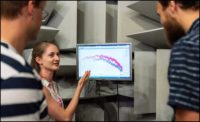- Air-handling system - Fire alarm system;
- Chilled water system - Air-handling system; and
- Heating hot water system - Heating hot water terminal units.
The Sum of All Parts
For example, consider air-handling system/fire alarm system integration. A typical scenario is to have the fire alarm system send a stop signal to an air-handling system when specific fire alarm devices are activated. To test this interface, the air-handling system functional performance test (FPT) can include overriding the fire alarm input signal to simulate a fire condition. The air handler FPT can confirm that the air-handling system shuts down as specified with valves and dampers moving to their appropriate positions and fans stopping in a safe manner. This is the air-handling unit FPT portion of the integrated system checkout.The fire alarm FPT, which can be conducted at any time either before or after the air-handling system FPT, can confirm that all specified devices send a signal to the AHU upon activation. This requires activating each individual device (smoke detector, pull station, sprinkler flow switch, etc.) and verifying that the appropriate binary output signal leaves the fire alarm control panel and is received by the AHU control panel.
In fact, once the binary output signal from the fire alarm system is confirmed to be "seen" by the air-handling system, it is no longer necessary to check that communication link for every fire alarm device. It should simply be necessary to confirm that the binary output signal is sent from the fire alarm system, because it is typically the same output point regardless of which device initiates the response.
Thus, it is not necessary to verify for each fire alarm device (and there are usually many of them) that the air-handling system shuts down and the valves and dampers assume their specified shut-down positions. This method of integrated system testing will also save the time associated with restarting each AHU in order to be ready for the next fire alarm device test.
How To Save Time And Money
In the chilled water system-air-handling system example, the air-handling system may be designed to switch from economizer mode to minimum outside air mode only if chilled water is available. This does not mean that the chilled water system needs to be started/stopped multiple times while testing the AHU - a costly and time consuming process.Let's say that chilled water availability is defined as the chilled water supply temperature being below 45°F and the chilled water pump being on. These air-handling system control input points can be overridden as part of the air-handling system FPT to prove air handler performance under both chilled water "available" and chilled water "unavailable" conditions. The chilled water system FPT, on the other hand, can simply include verification of the accuracy/reliability of the temperature and pump status signals sent to the AHU controller.
A final example is possible integration between the central heating hot water system and the terminal units served by it. The design engineer may have specified that the central hot water supply temperature be reset upwards in response to an unsatisfied call for heating from one or more terminal unit controllers. The terminal unit FPT can verify that a signal is sent from the terminal unit controller to the hot water system controller when the terminal unit valve is fully open. The hot water system FPT can confirm that the central temperature control valve or boiler responds as specified to the terminal unit control signals.
In addition to saving significant labor hours in the testing process itself, this approach to integrated system performance testing will also allow for staged and flexible testing schedules. It is not necessary that all systems be complete and operational prior to performing functional performance testing for individual systems. Just think of how much testing time would have to be figured into the construction schedule if you couldn't start testing AHUs until the fire alarm system is complete. ES




